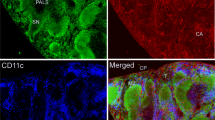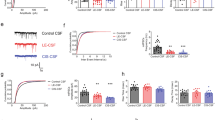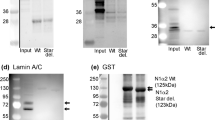Abstract
SMOOTH muscle antibody (SMA) found in the sera of some patients with active chronic hepatitis (ACH)1 has been shown to contain specific anti-actin antibody2,3. These SMA sera have been used to demonstrate the presence of the corresponding antigen in normal2 and neoplastic4–6 ‘non-muscle’ tissues. We have demonstrated that SMA serum reacts with normal, neoplastic and foetal astrocytes but not with neurone cell bodies5,7. The present report deals with the reaction of SMA with synaptic endings in the central nervous system (CNS).
This is a preview of subscription content, access via your institution
Access options
Subscribe to this journal
Receive 51 print issues and online access
$199.00 per year
only $3.90 per issue
Buy this article
- Purchase on Springer Link
- Instant access to full article PDF
Prices may be subject to local taxes which are calculated during checkout
Similar content being viewed by others
References
Johnson, G. D., Holborow, E. J., and Glynn, L. E., Lancet, ii, 878–879 (1965).
Gabbiani, G., et al., Am. J. Path., 72, 473–484 (1973).
Lidman, K., et al., Clin. exp. Immun., 24, 266–272 (1976).
Toh, B. H., and Muller, H. K., Cancer Res., 35, 3741–3745 (1975).
Toh, B. H. and Muller, H. K., and Elrick, W. L., Br. J. Cancer, 33, 195–202 (1976).
Toh, B. H., Hard, G. C., Cauchi, M. N., and Muller, H. K., Br. J. Cancer (in the press).
Toh, B. H., Muller, H. K., and Cauchi, M. N., Aust. J. exp. Biol. Med. Sci. (in the press).
Livett, B. G., Rostas, J. A. P., Jeffrey, P. L., and Austin, L., Expl Neurol., 43, 330–338 (1974).
Norton, W. T., and Poduslo, S. E., J. Neurochem., 21, 749–757 (1973).
Nairn, R. C., Fluorescent Protein Tracing (Churchill Livingstone, Edinburgh, 1976).
Clarke, F. M., Lovell, S. J., Masters, C. J., and Winzor, D. J. Biochim. biophys. Acta, 427, 617–626 (1976).
Livett, B. G., Howe, P. R. C., Fenwick, E. M., and Austin, L., in Recent Advances in Myology, 215–223 (Excerpta Medica, Amsterdam, 1974).
Eccles, J. C., Ito, M., and Szentagothai, J., The cerebellum as a Neuronal Machine (Springer, Verlag, Berlin, 1967).
Metuzals, J., and Mushynski, W. E., J. Cell Biol., 61, 701–722 (1974).
LeBeux, Y. J., and Willemot, J., Cell Tiss. Res., 160, 37–68 (1975).
Berl, S., Puszkin, S., and Nicklas, W. J., Science, 179, 441–446 (1973).
Wellington, B. S., Livett, B. G., Jeffrey, P. L., and Austin, L., Neurosci., 1, 23–34 (1976).
Author information
Authors and Affiliations
Rights and permissions
About this article
Cite this article
TOH, B., GALLICHIO, H., JEFFREY, P. et al. Anti-actin stains synapses. Nature 264, 648–650 (1976). https://doi.org/10.1038/264648a0
Received:
Accepted:
Issue Date:
DOI: https://doi.org/10.1038/264648a0
This article is cited by
-
Diagnostic autoantibodies for autoimmune liver diseases
Clinical & Translational Immunology (2017)
-
A review of neurotoxicity of microcystins
Environmental Science and Pollution Research (2016)
-
Localization of ATPase activity in dendritic spines of the cerebral cortex
Journal of Neurocytology (1991)
-
Monoclonal antibody to rat brain actin antigenically enhanced with HVJ (Sendai Virus) M protein
Histochemistry (1988)
-
Synapsin I bundles F-actin in a phosphorylation-dependent manner
Nature (1987)
Comments
By submitting a comment you agree to abide by our Terms and Community Guidelines. If you find something abusive or that does not comply with our terms or guidelines please flag it as inappropriate.



